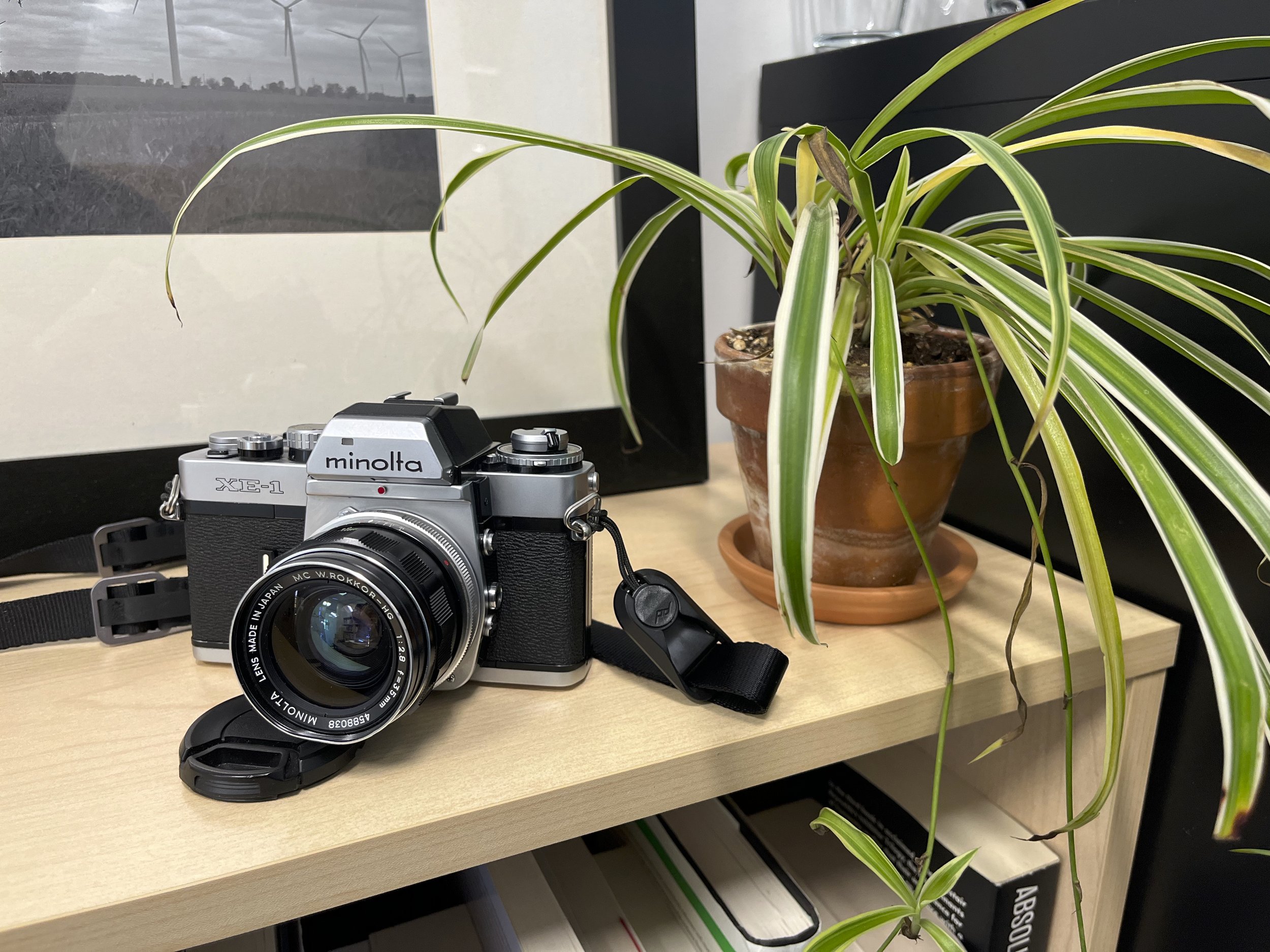Minolta XE-5
Version 1.0.4, last modified November 3rd, 2024 (with a link to my review of the Leica R3)
Introduction
A Lower-priced XE-7
A couple of months ago, I was drawn to investigate Minolta cameras after learning about the historical collaboration between the Japanese manufacturer and Leitz, which, beginning in the early 1970s and spanning approximately two decades, birthed the XE and XD cameras as well as the Leica R3-R7 series of SLRs. As I was familiarizing myself with the XE/XE-1/XE-7, I learned of its lower-priced sibling, the Minolta XE-5 (quite accidentally, while I was browsing Craigslist.) The XE-5 was identical to the XE-7 except that it had an inferior, less informative viewfinder and also lacked a few minor features. Specifically, the XE-5 did not have multi-exposure capability, an eye piece blind, a film advance confirmation indicator, and FP flash synchronization, all of which were available in the XE-7.
The XE-5 was released in 1975, though it was not sold in Minolta’s home market of Japan. As far as I can tell, it was available in only one finish: black-with-chrome-trim. This was distinguished from the same finish in the XE/XE-1/XE-7 by the black-, rather than chrome-faced, pentaprism housing in the XE-5. I bought mine packaged with a 50 mm f/1.7 MD Rokkor-X lens (shown above) for C$65 from a local seller on Craigslist.
The better camera
The XE-5 is very similar to the XE/XE-1/XE-7. If you’re more interested in the higher-specified camera, read this review instead.
Construction and Power Supply
Like the Minolta XE/XE-1/XE-7, the XE-5 was a spare, beautiful camera. Its substantial, boxy chassis was ruggedly built to close tolerances, mostly from metallic parts, giving a solid feeling of quality engineering in the hand. The utilitarian industrial design was very much of its time and proudly proclaimed competence over comfort. The camera’s confidently understated aesthetic gave little consideration to ergonomics beyond modest rounding of the corners, and appealed to the advanced amateur photographer who was above all concerned with performance.
The XE-5 was an electro-mechanical camera that required batteries for operation of the shutter at every manually-selected speed other than “X” (1/90 s) and “B” (bulb), as well as for stepless, aperture-priority auto-exposure (“AUTO”). A 3 V supply was required, either by way of two 1.5 V A76 (LR 44) batteries, or a single 3 V 1/3N battery. The XE lacked contacts for an external motor drive.
Layout and Nomenclature
Reproduced below are pages 6 and 7 of the Minolta XE-5 user manual, showing the layout of the camera in detail. (Click, or tap, to enlarge.)
The placement of dials and levers was traditional in the XE-5: the left-hand side of the top plate of the camera (with lens facing away from the photographer) featured a combination ASA-exposure compensation collar surrounding the film rewind crank (both having locks to prevent inadvertent movement), while the right-hand side featured the shutter speed selection dial (including B, X, and AUTO settings), a threaded shutter-release button, and plastic-tipped film-advance crank. The rear face of the camera featured an on-off switch to the right of the viewfinder, and a memo holder for the loaded film. The images below show these features in detail.
View of the top plate of the Minolta XE-5.
View of the rear face of the Minolta XE-5.
Features
Shutter and flash synchronization. The XE-5 featured a very quiet and reliable metallic, vertically-travelling, focal-plane shutter that was built by Copal and Leitz. Speeds ranged from 4 s to 1/1000 s and bulb (“B”). Synchronization for electronic flash (X, 1/90 s) was provided by a hot shoe on the top of the camera and a PC port at the 3 o’clock position of the lens mount.
Exposure Modes. The XE-5 offered both aperture-priority automatic (“AUTO”) and metered manual exposure modes. (Prior to the XE-5, the only Minolta cameras to feature the former were the professional-grade X-1—also known as the XK and XM—which debuted in 1973, and the XE/XE-1/XE-7 of 1974.) When the dial was set to “AUTO,” shutter speed was varied steplessly by the camera; otherwise, speeds could be adjusted manually in full stop increments only. Film speeds could be set in the range of ISO 12-3200. The XE-5 did not have automatic DX decoding.
Metering. Through-the-lens metering was provided at full aperture by Minolta’s Contrast Light Compensation (CLC) system which employed two cadmium sulfide (CdS) cells that were mounted at different positions on the pentaprism. According to the user manual, these took “separate, overlapping light readings” and were “circuited so that the reading of each affect[ed] that of the other to automatically yield optimal exposure in both normal and high-contrast situations.” This system, which debuted in Minolta’s SRT series of cameras in the 1960s, was designed so that, when the camera was held in landscape orientation, the meter was not overwhelmed by the brightness of the sky to the detriment of proper exposure of the darker landscape. Effectively, the lower CdS cell was twice as sensitive as the upper to ensure even exposure of light and dark areas.
The CdS cells had long and reliable lifetimes. They were sensitivity to the same colours of light as the human eye. However, as the manual warned, they also suffered from the same “memory effect” that plagues the human eye. That is, “the time of response varied with the intensity of light falling on them. It thus took them a while to become accustomed to low light levels after exposure to bright light.” I have indeed confirmed this lag for myself: it may take a few seconds for the XE-5’s meter to achieve an accurate, stable reading in low light after the camera has been exposed to bright light.
What is metering?
If you’re new to (film) photography, check out my article on the fundamentals of metering.
Focussing. The XE-5 was a manual-focus camera. Focus was achieved by turning the barrel of the lens until the bottom and top halves of the split screen were aligned within the viewfinder. In more sophisticated, later-model cameras, like the Nikon F100, manual focus was confirmed by illumination of an in-focus indicator light in the viewfinder. The XE did not have this feature.
Viewfinder and focussing screen. The XE-5 featured an eye-level, fixed pentaprism-type viewfinder with 94% coverage and 0.8x magnification (at 50 mm, focussed to infinity.) It had a matte-Fresnel-field focussing screen with a central, horizontally-oriented split-image focussing spot surrounded by a microprism band. Shown below is a schematic of the XE-5’s viewfinder, taken from page 24 of the user manual.
Like the XE/XE-1/XE-7, the XE-5 showed the metered shutter speed for the selected aperture by way of a needle scale on the right-hand side of the viewfinder in both aperture-priority automatic and manual modes. Unlike the XE/XE-1/XE-7, the XE-5 did not show the selected shutter speed in the viewfinder when the camera was in manual mode, nor did it show “A”, “B”, or “X” when the camera was placed in these other modes. The inferior viewfinder alone is enough for me to prefer the XE/XE-1/XE-7 over the XE-5, despite the lower price of the latter camera.
Lens Compatibility. The XE-5 was designed to be fully compatible with SR-mount MC lenses, which were well-built, optically excellent, and available in focal lengths ranging from 7.5 mm to 1,600 mm. The camera was also compatible with the later MD line of lenses that was released alongside the Minolta XD; in the XD, the MD line of lenses offered shutter- as well as aperture-priority autoexposure. The XE-5 could be used with earlier Minolta lenses with stop-down metering.
Other Features. In no particular order:
Depth-of-field preview
Self-timer with 6-10 second variable delay
Battery check light
Loaded film memo holder
Threaded cable release
Hot shoe
PC-socket with X flash sync
Tripod socket
Differences between the XE/XE-1/XE-7 and XE-5
The Minolta XE-5 was very similar to the XE/XE-1/XE-7 which preceded. The photos below highlight the external differences between these two cameras.
Above: Comparison of the right-hand sides of the top faces of the XE/XE-1/XE-7 (left) and XE-5 (right) showing lack of double-exposure switch in the latter.
Above: Comparison of the rear faces of the XE/XE-1/XE-7 (top) and XE-5 (bottom) showing lack of eyepiece blind switch (left of viewfinder) and film-advance confirmation indicator (right of on-off switch) in the latter.
Above: Comparison of the left-hand sides of the lens mounts in the XE/XE-1/XE-7 (top) and XE-5 (bottom). In the XE/XE-1/XE-7, there is a switch allowing choice of flash sync between FP (labelled in green) and X (labelled in red). Flash sync is limited to X in the XE-5.
Aesthetics and Handling
If you are coming to the XE-5 from a DSLR or late-model, fully electronic SLR, you may be surprised by how simple and stripped-down it is. The camera body has very few controls. There is a shutter release button for taking pictures, a depth-of-field preview button, an integrated shutter speed and ISO selection dial, self-timer control, and a film advance lever. That’s it. These analog controls are laid out beautifully and provide very positive tactile sensations.
Pros and Cons
PROS
Leica DNA without the Leica price tag. Less expensive than the R3.
High build quality, durability, and reliability.
Compatible with a large selection of excellent, relatively inexpensive SR mount MC and MD lenses
Simple, intuitive controls with excellent layout and positive haptics.
Large bright viewfinder with easy focussing via a split-screen.
Retro-aesthetic with a unique sharply-dressed look owing to the all-black pentaprism housing.
CONS (in decreasing order of importance to me)
I found it difficult to get used to Minolta’s CLC system, which I found to be less reliable than centre-weighted metering.
Inferior viewfinder compared to the XE/XE-1/XE-7 (lack of selected aperture and shooting mode).
Lack of selected shutter speed in the viewfinder when the camera is in manual mode (as in the XE/XE-1/XE-7).
Slow return to accurate metering during transitions from bright to low-light situations.
Lack of shutter-priority auto-exposure and program modes.
Lack of autofocus.
Lack of mirror lock-up.
Lack of motor drive.
The Big German Brother
The Leica R3 is the near twin of the Minolta XE-1 and the big German brother to the Minolta XE-5. How do they stack up?
Buying Advice
The Minolta XE-5 is well-made, reliable, inexpensive camera. Although it is cheaper than the XE/XE-1/XE-7, I don’t believe that it offers better value-for-money. The XE/XE-1/XE-7’s modestly higher price is more than justified by its superior viewfinder. The XE-5 is fully compatible with SR-mount MC and MD lenses, which can readily be had at low prices. These generally have excellent build and optical quality as they too have inherited Leica know-how. You can’t go wrong with either the XE/XE-1/XE-7 or the XE-5, but if I had to choose, I would go with the former.
Sample Photos
All of the sample photographs above were exposed on Fujifilm 400 colour negative film using the XE-5 mounted with an MD Rokkor-X 50 mm f/1.7 lens. The negatives were home-developed using a Cinestill CS41 two-bath kit, scanned with an Epson V700 flat-bed scanner, inverted with Negative Lab Pro, and lightly processed in Lightroom.
Other Resources
Other camera reviews
Since 2023, I have been working to review all of the cameras that I own and use. This is a large project because my collection contains 33 cameras spanning 6 brands. For a complete list of my cameras and the current status of the project, see Completed and Upcoming Film Camera Reviews.
This is the second in my series of Minolta camera reviews. The first was that of the Minolta XE/XE-1/XE-7.


























